Impact of Two-Way FDI on China’s Environmental Quality: The Perspective of Environmentally Cleaner Production and End Treatment
Abstract
1. Introduction
2. Literature Review
3. Materials and Methods
3.1. Study Motivation
3.2. Method
3.2.1. Comprehensive Evaluation Method
3.2.2. Dagum Gini Coefficient
3.2.3. Dynamic Panel Model
3.3. Research Data
3.3.1. Dependent Variables
3.3.2. Independent Variables
3.3.3. Control Variables
3.4. Data Description
4. Feature Fact Description and Evolution Analysis
4.1. Feature Fact Description
4.1.1. Scale Development of IFDI
4.1.2. Scale Development of OFDI
4.1.3. IFDI Regional Differences
4.1.4. OFDI Regional Differences
4.2. Analysis of the EQI, EPI and ETI
4.2.1. Overall Evolution Trend
4.2.2. Distribution Map of EQI, EPI and ETI
5. Spatial Difference Analysis
5.1. Overall Regional Differences
5.2. Intra-Regional Differences
5.3. Inter-Regional Differences
6. Empirical Results and Discussion
6.1. Simulation Test
6.1.1. Unit-Root Test
6.1.2. Panel Cointegration Tests
6.2. Dynamic Panel Regression Analysis
6.2.1. Overall National Regression Analysis
6.2.2. Regional Regression Analysis
6.3. Discussion
7. Conclusions
Author Contributions
Funding
Institutional Review Board Statement
Informed Consent Statement
Data Availability Statement
Conflicts of Interest
Abbreviations
| FDI | Two-way foreign direct investment |
| IFDI | Inward foreign direct investment |
| OFDI | Outward foreign direct investment |
| EQI | The comprehensive environmental quality index |
| EPI | The environmentally cleaner production index |
| ETI | The environmental end treatment index |
| SYS-GMM | A system-generalised method-of-moments |
| FE | Fixed effects model |
| CPC | The Communist Party of China |
| ASEAN | Association of Southeast Asian Nations |
| G | The overall Gini coefficient |
| Gw | The intra-regional differences |
| Gnb | The inter-regional differences |
| Gt | The hypervariable densities |
| E-C | East–central |
| E-W | East–west |
| C-W | Central–west |
| Obs | Observed value |
| Std. Dev. | Standard deviation |
| CSY | China Statistical Yearbook |
| PSY | Provincial Statistical Yearbook |
| Wind | Wind database |
| R&D | Research and development |
| lnEQI | Ln (provincial comprehensive environmental quality index) |
| lnEPI | Ln (provincial environmentally cleaner production index) |
| lnETI | Ln (provincial environmental end treatment index) |
| lnIFDI | Ln (provincial IFDI flow) |
| lnOFDI | Ln (provincial OFDI flow) |
| ln(IFDI×OFDI) | Ln (provincial IFDI flow × provincial OFDI flow) |
| lnED | Ln (provinces’ GDP/population of each province) |
| IND | Provinces’ tertiary sector value added/provinces’ GDP |
| ES | Proportion of coal in energy consumption of each province |
| ER | Provinces’ pollution treatment cost/provinces’ added value of secondary industry |
| RD | Research and development investment: provinces’ R&D investment/provinces’ GDP |
| lnPOP | Ln (population density: population of each province/total provinces’ area) |
References
- Duan, H.; Yuan, D.; Cai, Z.; Wang, S. Valuing the impact of climate change on China’s economic growth. Econ. Anal. Policy 2022, 74, 155–174. [Google Scholar] [CrossRef]
- Li, Z.; Li, N.; Wen, H. Digital Economy and Environmental Quality: Evidence from 217 Cities in China. Sustainability 2021, 13, 8058. [Google Scholar] [CrossRef]
- Yang, W.; Zhang, Z.; Luo, P.; Wang, Y. Temporal and spatial evolution and influencing factors of urban ecological total factor productivity in the Yellow River basin under strong sustainable development. Sci. Progress 2023, 106, 1–33. [Google Scholar] [CrossRef] [PubMed]
- Wen, H.; Lee, C.; Zhou, F. Green credit policy, credit allocation efficiency and upgrade of energy-intensive enterprises. Energy Econ. 2021, 94, 105099. [Google Scholar] [CrossRef]
- Zhao, B.; Yang, W. Allocation of carbon emission allowance based on DLA-GA model: A case study in China. Environ. Sci. Pollut. Res. 2022, 29, 15743–15762. Available online: https://link.springer.com/article/10.1007/s11356-021-16643-y (accessed on 11 October 2021). [CrossRef]
- List, J.A.; Co, C.Y. The Effects of Environmental Regulations on Foreign Direct Investment. J. Environ. Econ. Manag. 2000, 40, 1–20. [Google Scholar] [CrossRef]
- Zhang, C.; Zhou, X. Does foreign direct investment lead to lower CO2 emissions? Evidence from a regional analysis in China. Renew. Sustain. Energy Rev. 2016, 58, 943–951. [Google Scholar]
- Benarroch, M.; Thille, H. Transboundary pollution and the gains from trade. J. Int. Econ. 2001, 55, 139–159. [Google Scholar] [CrossRef]
- Ali, S.; Yusop, Z.; Kaliappan, S.R.; Chin, L. Dynamic common correlated effects of trade openness, FDI, and institutional performance on environmental quality: Evidence from OIC countries. Environ. Sci. Pollut. Res. 2020, 27, 11671–11682. [Google Scholar] [CrossRef]
- Aslan, A.; Altinoz, B.; Atay Polat, M. The nexus among climate change, economic growth, foreign direct investments, and financial development: New evidence from N-11 countries. Environ. Prog. Sustain. Energy 2021, 40, e13585. [Google Scholar] [CrossRef]
- Hu, K.; Shi, D. The impact of government-enterprise collusion on environmental pollution in China. J. Environ. Manag. 2021, 292, 112744. [Google Scholar] [CrossRef]
- Zakari, A.; Khan, I. Boosting economic growth through energy in Africa: The role of Chinese investment and institutional quality. J. Chin. Econ. Bus. Stud. 2021, 20, 1–21. [Google Scholar] [CrossRef]
- Perkins, R.; Neumayer, E. Transnational linkages and the Spillover of Environment-Efficiency into Developing Countries. Environ. Econ. 2009, 19, 375–383. [Google Scholar] [CrossRef]
- Letchumanan, R.; Kodama, F. Reconciling the conflict between the ‘pollution-haven’ hypothesis and an emerging trajectory of international technology transfer. Res. Policy 2000, 29, 59–79. [Google Scholar] [CrossRef]
- Sitthivanh, P.; Srithilat, K. The Impact of Foreign Direct Investment on Environmental Quality in ASEAN Countries. J. Resour. Energy Dev. 2022, 18, 27–40. [Google Scholar] [CrossRef]
- Ayamba, E.C.; Haibo, C.; Ibn Musah, A.; Ruth, A.; Osei-Agyemang, A. An empirical model on the impact of foreign direct investment on China’s environmental pollution: Analysis based on simultaneous equations. Environ. Sci. Pollut. Res. 2019, 26, 16239–16248. [Google Scholar] [CrossRef]
- Xiao, D.; Gao, L.; Xu, L.; Wang, Z.; Wei, W. Revisiting the Green Growth Effect of Foreign Direct Investment from the Perspective of Environmental Regulation: Evidence from China. Int. J. Environ. Res. Public Health 2023, 20, 2655. [Google Scholar] [CrossRef]
- Qamruzzaman, M. Nexus between environmental quality, institutional quality and trade openness through the channel of FDI: An application of common correlated effects estimation (CCEE), NARDL, and asymmetry causality. Environ. Sci. Pollut. Res. 2021, 28, 52475–52498. [Google Scholar] [CrossRef]
- Hao, Y.; Wu, Y.; Wu, H.; Ren, S. How do FDI and technical innovation affect environmental quality? Evidence from China. Environ. Sci. Pollut. Res. 2019, 27, 7835–7850. [Google Scholar] [CrossRef]
- Li, L.; Liu, X.; Yuan, D.; Yu, M. Does outward FDI generate higher productivity for emerging economy MNEs? Micro-level evidence from Chinese manufacturing firms. Int. Bus. Rev. 2017, 26, 839–854. [Google Scholar] [CrossRef]
- Fu, X.; Hou, J.; Liu, X. Unpacking the relationship between outward direct investment and innovation performance: Evidence from Chinese firms. World Dev. 2018, 102, 111–123. [Google Scholar] [CrossRef]
- Tang, D.; Shan, Z.; He, J.; Zhao, Z. How Do Environmental Regulations and Outward Foreign Direct Investment Impact the Green Total Factor Productivity in China? A Mediating Effect Test Based on Provincial Panel Data. Int. J. Environ. Res. Public Health 2022, 19, 15717. [Google Scholar] [CrossRef] [PubMed]
- Hao, Y.; Guo, Y.; Guo, Y.; Wu, H.; Ren, S. Does outward foreign direct investment (OFDI) affect the home country’s environmental quality? The case of China. Struct. Chang. Econ. Dyn. 2020, 52, 109–119. [Google Scholar] [CrossRef]
- Zomorrodi, A.; Zhou, X. Impact of FDI on Environmental Quality of China. Int. J. Bus. Econ. 2017, 4, 1–15. [Google Scholar] [CrossRef][Green Version]
- Ouyang, Y.; Huang, X.; Zhong, L. The impact of enterprises’ foreign direct investment on environmental pollution in their home countries: Local effects and spatial spillovers. China Ind. Econ. 2020, 2, 98–121. [Google Scholar] [CrossRef]
- Muhammad, B.; Khan, S. Effect of bilateral FDI, energy consumption, CO2 emission and capital on economic growth of Asia countries. Energy Rep. 2019, 5, 1305–1315. [Google Scholar] [CrossRef]
- Gong, M.; You, Z. Environmental technology effect of two-way foreign direct investment interactive development in China. Front. Ecol. Evol. 2022, 8, 954614. [Google Scholar] [CrossRef]
- Liu, Z.; Liu, G.; Zhang, P. Does the Belt and Road Initiative increase the green technology spillover of China’s OFDI? An empirical analysis based on the DID method. Front. Environ. Sci. 2022, 11, 1043003. [Google Scholar] [CrossRef]
- Feng, Z.; Zeng, B.; Ming, Q. Environmental Regulation, Two-Way Foreign Direct Investment, and Green Innovation Efficiency in China’s Manufacturing Industry. Int. J. Environ. Res. Public Health 2018, 15, 2292. [Google Scholar] [CrossRef]
- Yuan, X.; Li, H.; Zhao, J. Impact of environmental pollution on health—Evidence from cities in China. Soc. Work. Public Health 2020, 35, 413–430. [Google Scholar] [CrossRef]
- Yang, W.; Li, D. Spatio-temporal Evolution of Ecological Environment Quality in China From a Concept of Strong Sustainability. Environ. Sci. Pollut. Res. 2022, 29, 28769–28787. [Google Scholar] [CrossRef] [PubMed]
- Dagum, C. A New Approach to the Decomposition of the Gini Income Inequality Ratio. Empir. Econ. 1997, 22, 515–531. [Google Scholar] [CrossRef]
- Zhao, B.; Yang, W.; Wen, J.; Zhang, W. The financial market in China under the COVID-19. Emerg. Mark. Financ. Trade 2022, 58, 3726–3738. [Google Scholar] [CrossRef]
- Yang, W.; Ban, L. The Green Sustainable Economic Development Model under Sustainable Use of Energy and Pollution Control. Theor. Econ. Lett. 2013, 3, 19–27. Available online: https://www.scirp.org/journal/paperinformation.aspx?paperid=28146 (accessed on 22 December 2022). [CrossRef]
- Wen, J.; Deng, P.; Zhang, Q. Is Higher Government Efficiency Bringing about Higher Innovation. Technol. Econ. Dev. Econ. 2021, 27, 626–655. [Google Scholar] [CrossRef]
- Yuan, H.; Feng, Y.; Lee, C.; Cen, Y. How does manufacturing agglomeration affect green economic efficiency? Energy Econ. 2020, 92, 104944. [Google Scholar] [CrossRef]
- Yuan, X.; Li, C.; Zhao, K.; Xu, X. The Changing Patterns of Consumers’ Behavior in China: A Comparison during and after the COVID-19 Pandemic. Int. J. Environ. Res. Public Health 2021, 18, 2447. [Google Scholar] [CrossRef]
- Duodu, E.; Kwarteng, E.; Oteng-Abayie, E.F.; Frimpong, P.B. Foreign direct investments and environmental quality in sub-Saharan Africa: The merits of policy and institutions for environmental sustainability. Environ. Sci. Pollut. Res. 2021, 28, 66101–66120. [Google Scholar] [CrossRef]
- Li, D.; Yang, W.; Huang, R. The multidimensional differences and driving forces of ecological environment resilience in China. Environ. Impact Assess. Rev. 2023, 98, 106954. [Google Scholar] [CrossRef]
- Dong, Z.; Wang, H. Urban Wealth and Green Technology Choice. Econ. Res. 2021, 56, 143–159. Available online: https://kns.cnki.net/kcms/detail/detail.aspx?dbcode=CJFD&dbname=CJFDLAST2021&filename=JJYJ202104010&uniplatform=NZKPT&v=9xsOiL1MsinO__GQUgcawN_m6qps5G4IrmlukMNXL4d_IMZhA4fMPgAMb78EsoNB (accessed on 20 April 2021).
- Chen, D. The decline of trade barriers and the improvement of environmental pollution—new evidence from the pollution data of Chinese enterprises. Econ. Res. 2020, 55, 98–114. Available online: https://kns.cnki.net/kcms/detail/detail.aspx?dbcode=CJFD&dbname=CJFDLAST2021&filename=JJYJ202012006&uniplatform=NZKPT&v=x7X5dmdiedO9fs8fieE9hww1c0L-GksRK_UyiZbhJJuFvImGbEAKAqvSaxcMi6DZ (accessed on 20 December 2020).
- Guo, M.; Li, H.; Lin, W. The impact of economic growth, FDI, and innovation on environmental efficiency of the logistics industry in provinces along the belt and road in China: An empirical study based on the panel Tobit model. Sci. Prog. 2021, 104, 1–24. [Google Scholar] [CrossRef] [PubMed]
- Madane, Y. The Institutional Factors Influencing Chinese Outward Investment in One Belt One Road Countries. IOSR J. Humanit. Soc. Sci. 2019, 24, 2279-0837. Available online: https://www.iosrjournals.org/ (accessed on 8 June 2019).
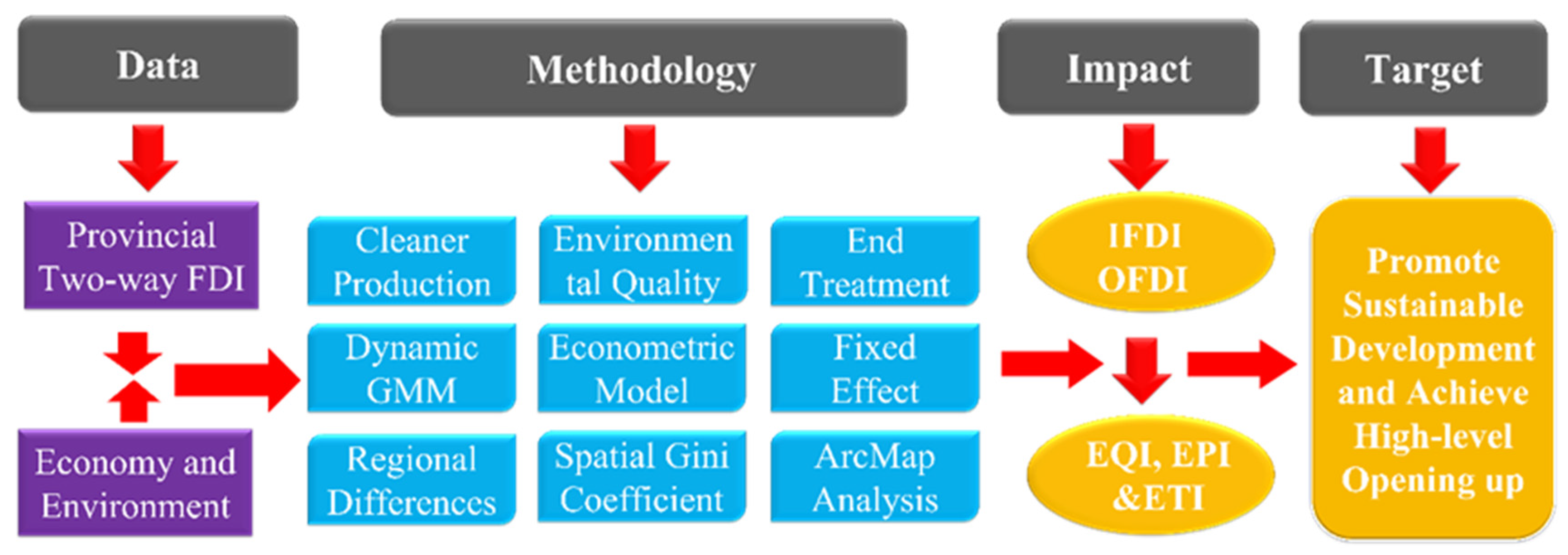
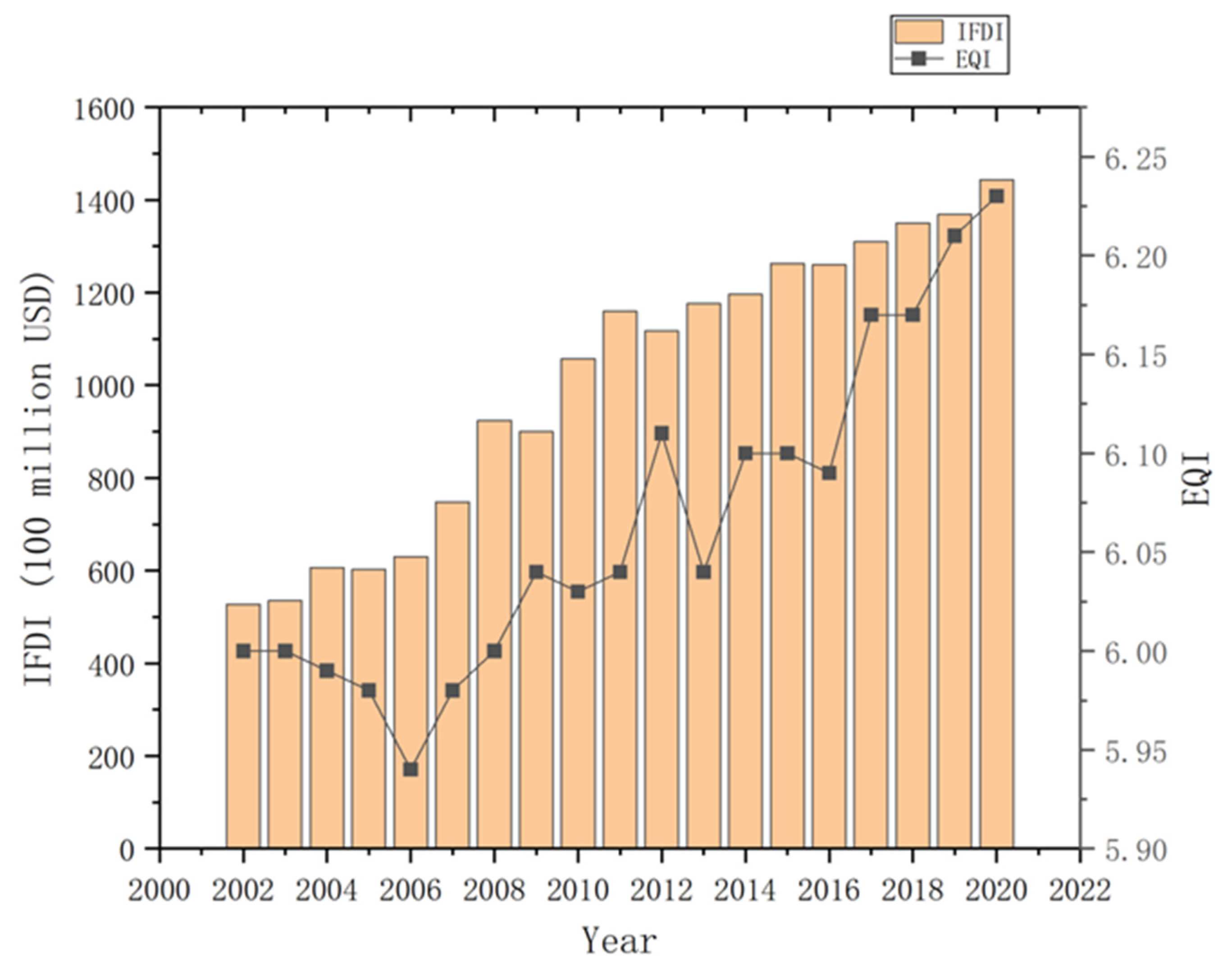
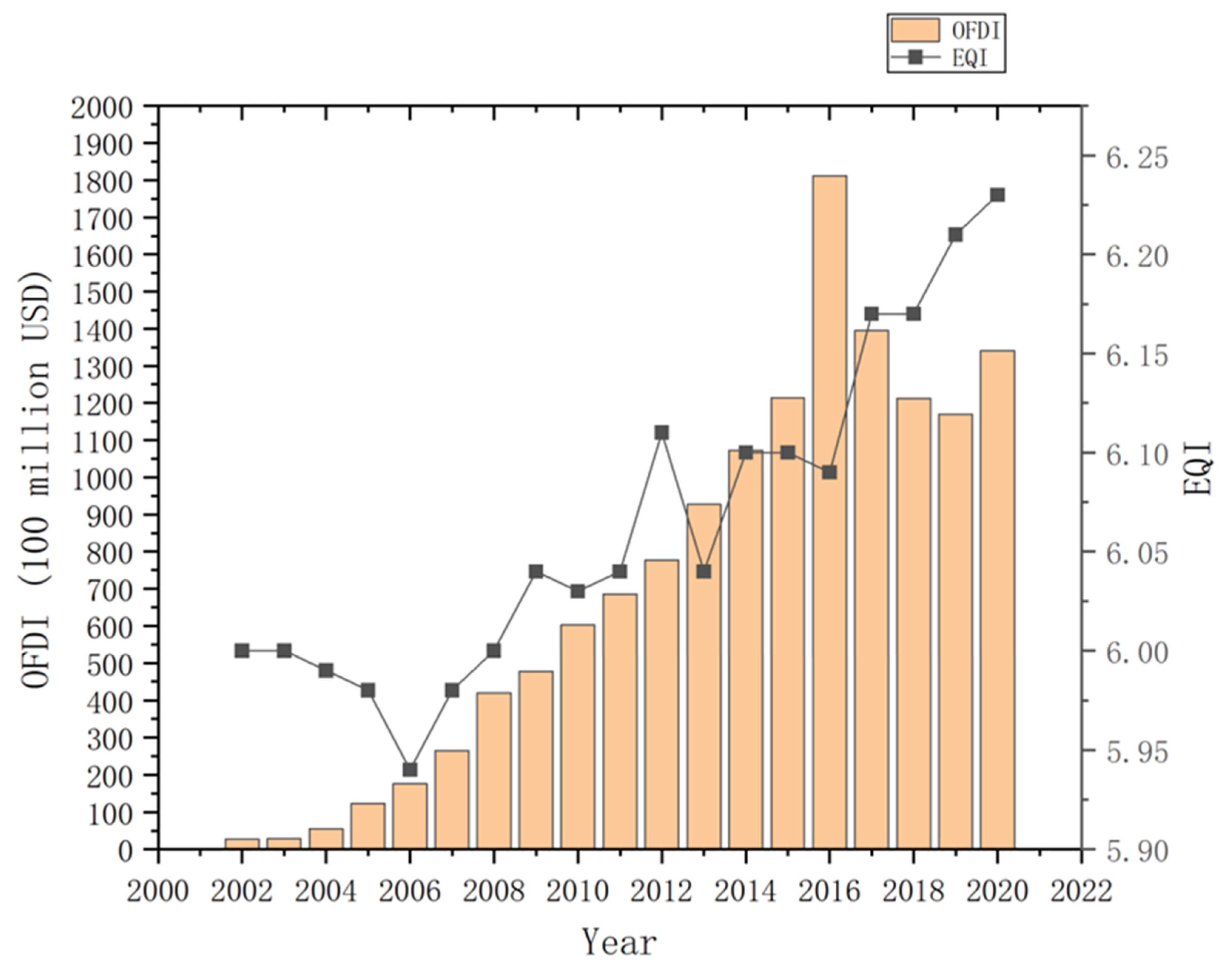
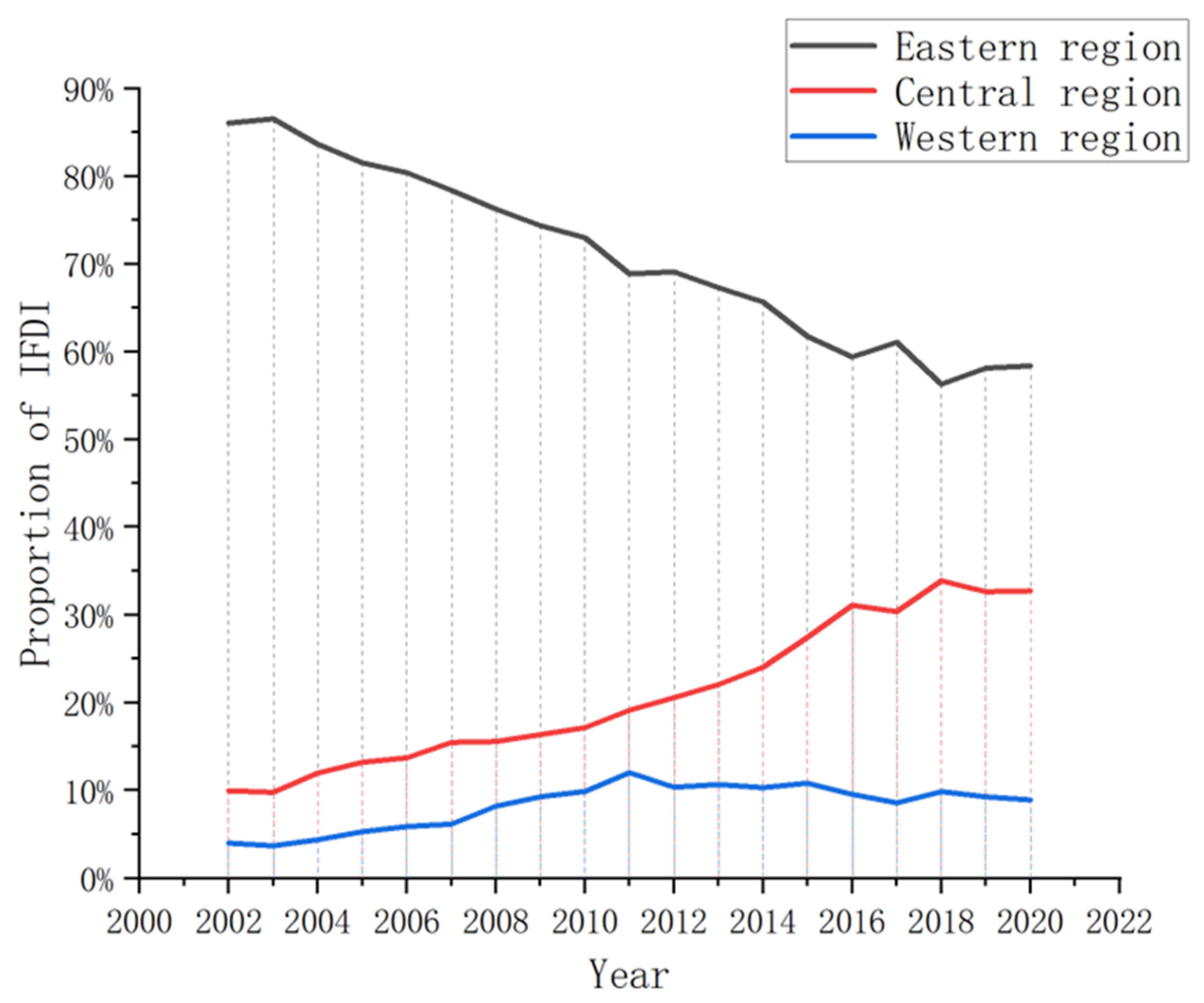

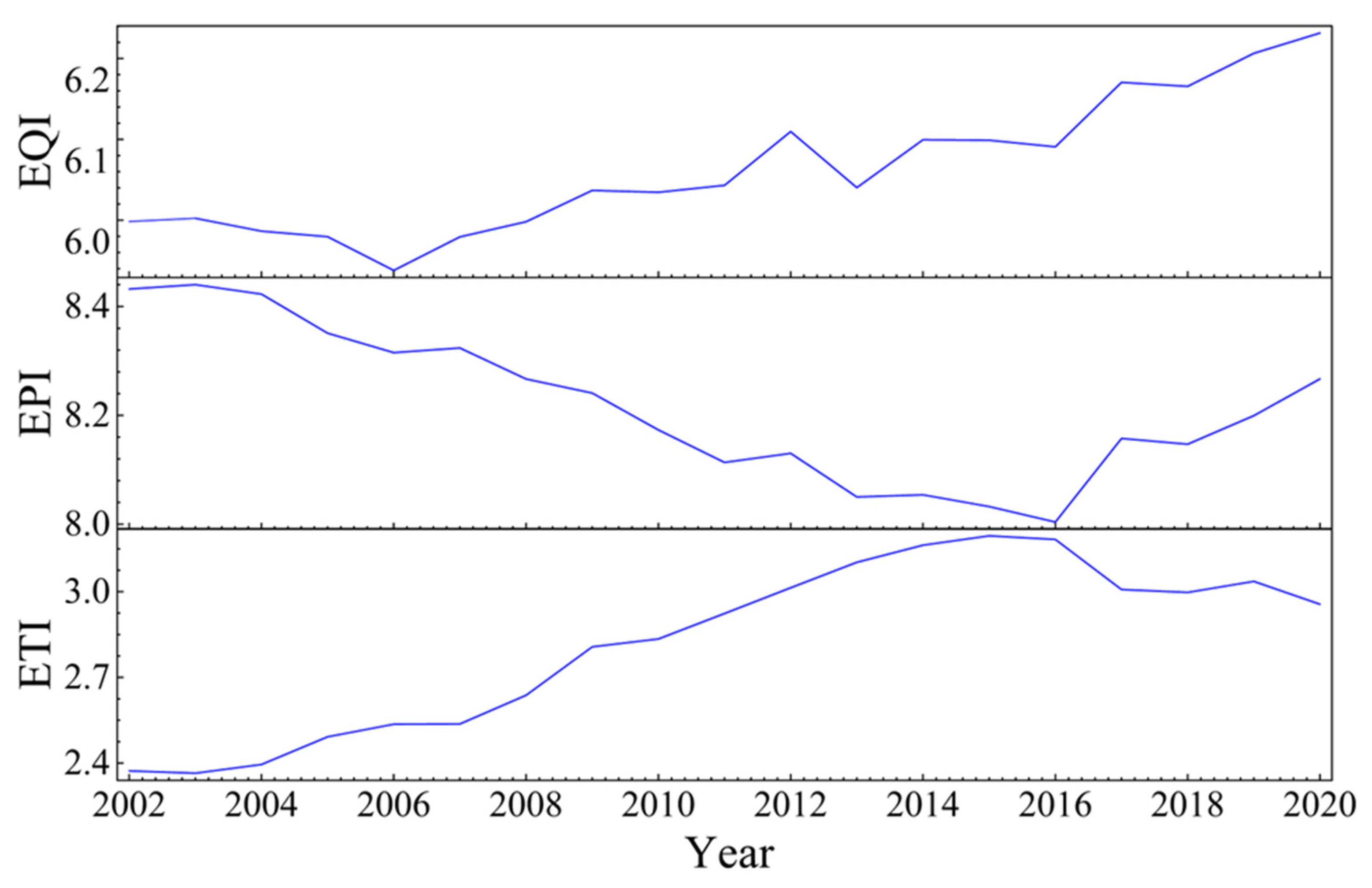
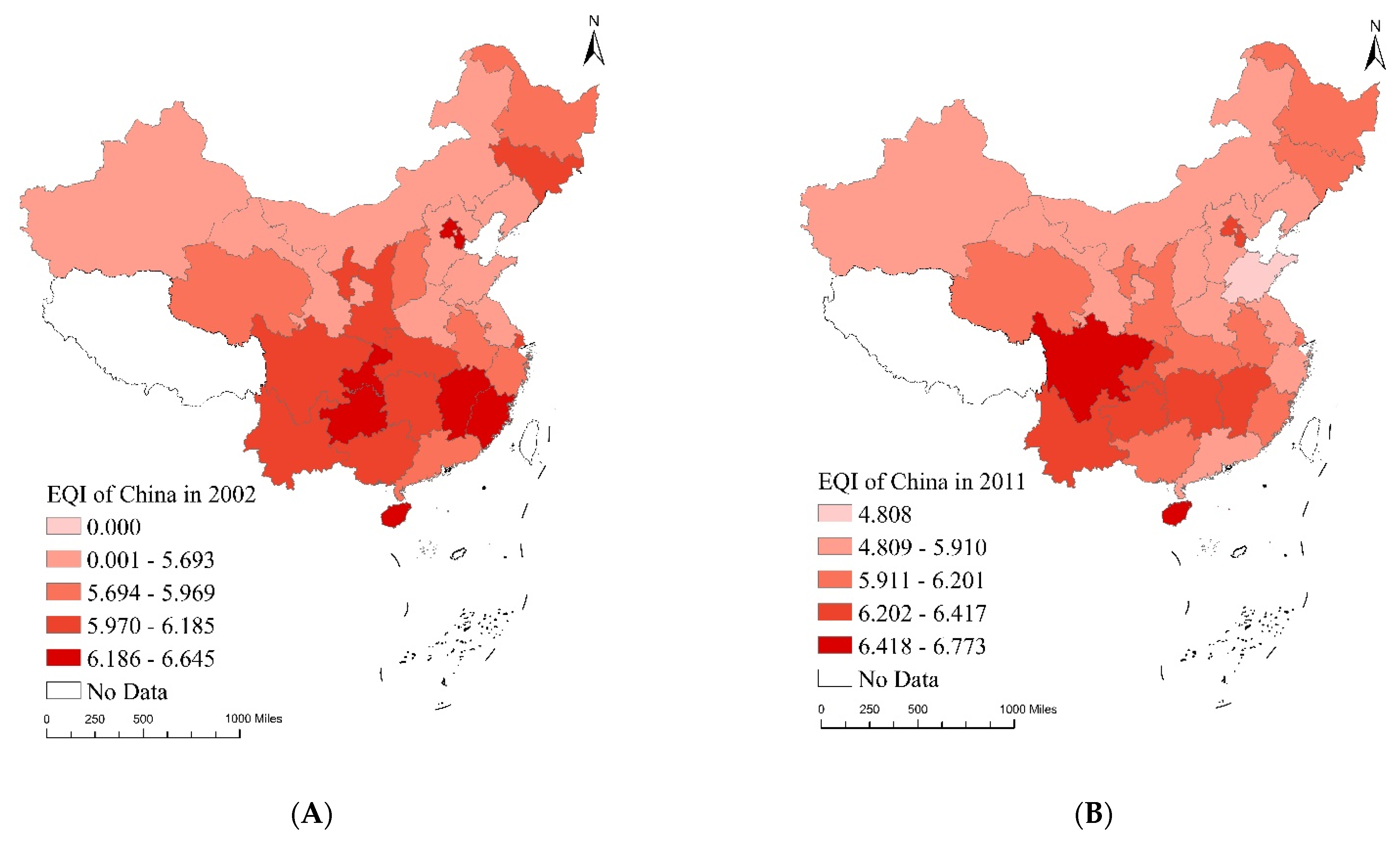
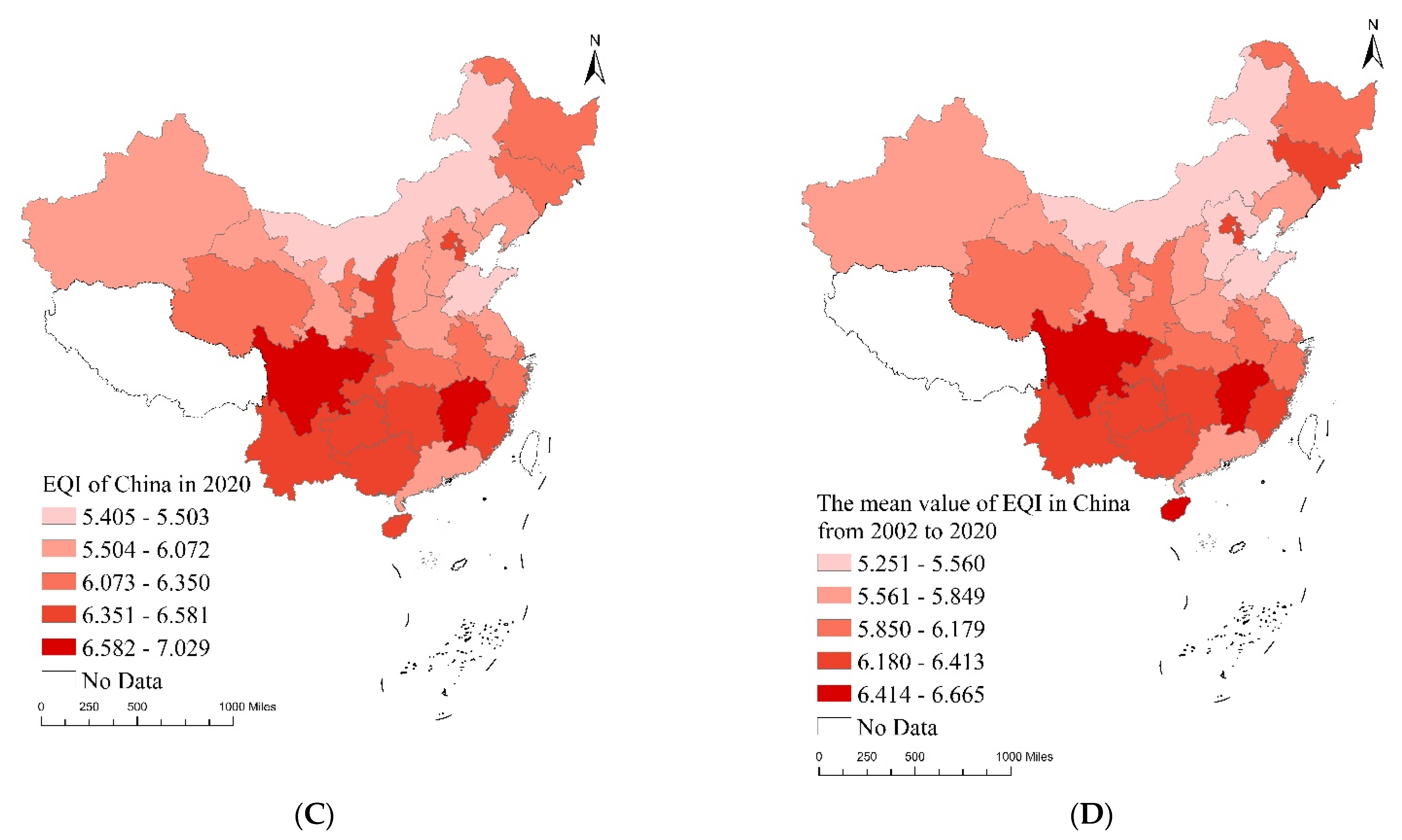
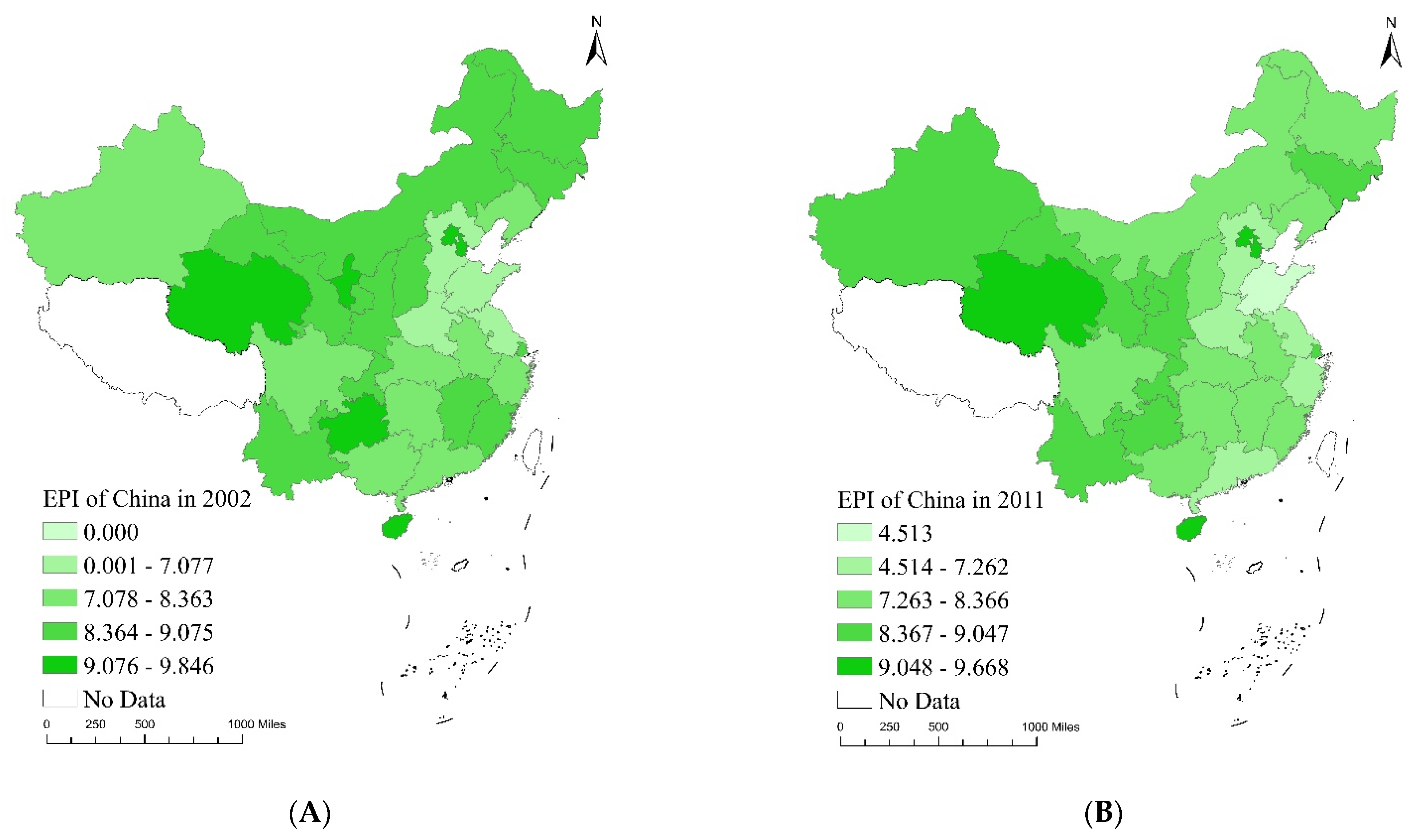
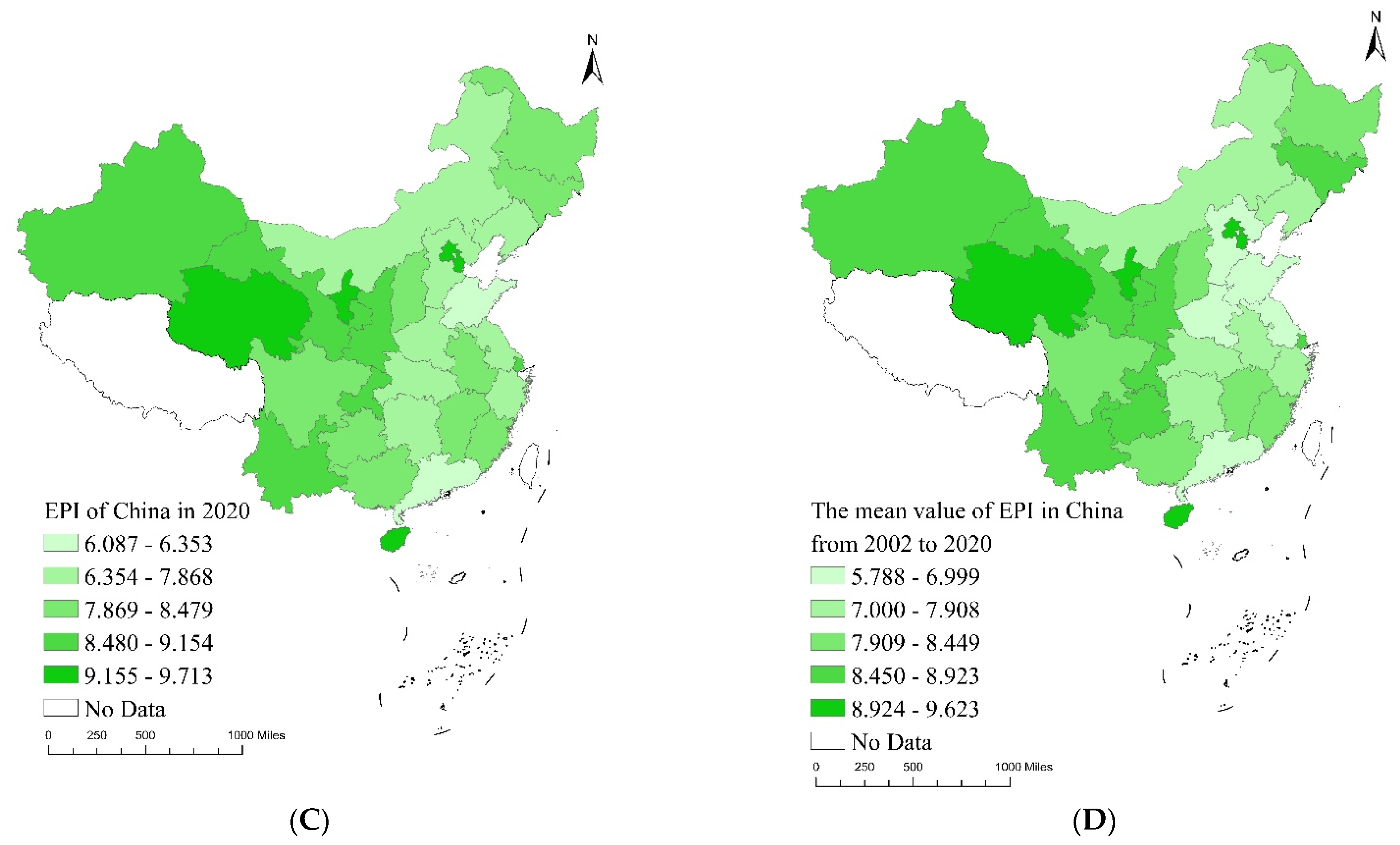
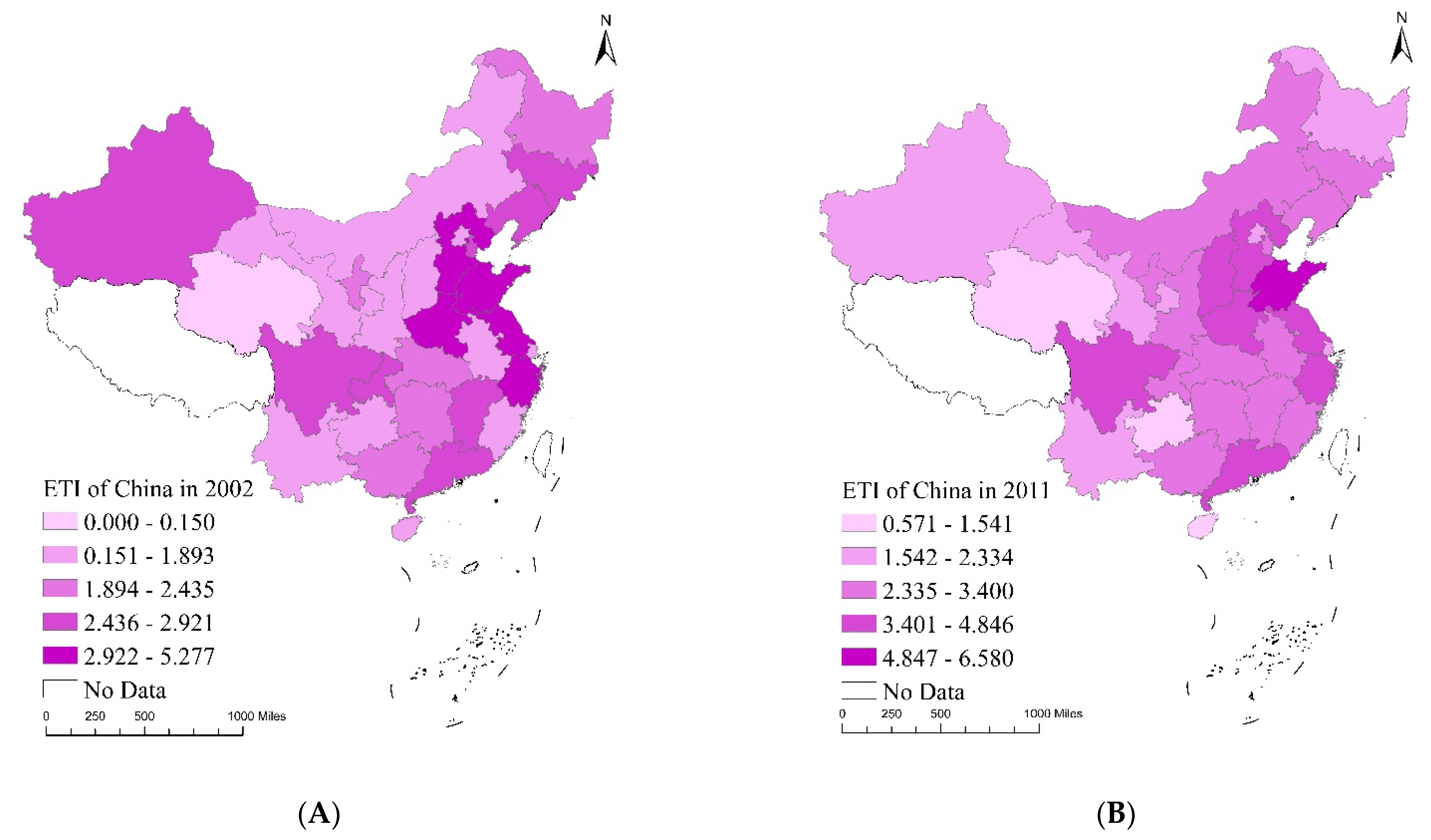

| Target | Dimension | Criterion | Specific Index | Unit | Attribute |
|---|---|---|---|---|---|
| Comprehensive environmental quality index (EQI) | Environmentally cleaner production index (EPI) | Industrial environmental pollution production | Industrial wastewater production | 10,000 tons | − |
| Industrial waste gas generation | 10,000 tons | − | |||
| Industrial smoke and dust production | 10,000 tons | − | |||
| Industrial dust production | 10,000 tons | − | |||
| Sulphur dioxide production | 10,000 tons | − | |||
| Production of industrial chemical oxygen demand | 10,000 tons | − | |||
| Industrial ammonia nitrogen production | 10,000 tons | − | |||
| Output of industrial solid waste | 10,000 tons | − | |||
| Production of industrial hazardous waste | 10,000 tons | − | |||
| Domestic environmental pollution production | Domestic waste production | 10,000 tons | − | ||
| Output of domestic wastewater | 10,000 tons | − | |||
| Area of environmental noise | km2 | − | |||
| Carbon dioxide production | 10,000 tons | − | |||
| Agricultural environmental pollution production | Fertiliser application amount | ton | − | ||
| Pesticide usage | ton | − | |||
| Area of soil erosion | km2 | − | |||
| Land desertification area | km2 | − | |||
| Environmental end treatment index (ETI) | Industrial pollution treatment | Industrial wastewater treatment amount | 10,000 tons | + | |
| Treatment amount of industrial smoke and dust | 10,000 tons | + | |||
| Industrial dust control amount | 10,000 tons | + | |||
| SO2 treatment amount | 10,000 tons | + | |||
| Chemical oxygen demand treatment amount | 10,000 tons | + | |||
| Ammonia nitrogen treatment amount | 10,000 tons | + | |||
| Solid waste treatment amount | 10,000 tons | + | |||
| Treatment amount of hazardous waste | 10,000 tons | + | |||
| Domestic pollution treatment | Domestic waste treatment amount | 10,000 tons | + | ||
| Domestic sewage treatment amount | 10,000 tons | + | |||
| Noise pollution control area | km2 | + | |||
| Construction area of high pollution, no burning area | km2 | + | |||
| Agricultural pollution treatment | Soil erosion control area | km2 | + | ||
| Land desertification control area | km2 | + | |||
| Input intensity of agricultural environmental governance | % | + |
| Variable | Definition | Source |
|---|---|---|
| EQI | Provincial comprehensive environmental quality index | Calculation |
| EPI | Provincial environmentally cleaner production index | Calculation |
| ETI | Provincial environmental end treatment index | Calculation |
| IFDI | Provincial IFDI flow | Wind |
| OFDI | Provincial OFDI flow | Wind |
| IFDI × OFDI | Interaction between IFDI and OFDI | Wind |
| ED | Economic development level: provinces’ GDP/population of each province | CSY |
| IND | Industrial structure: provinces’ tertiary sector value added/provinces’ GDP | CSY |
| ES | Energy structure: Proportion of coal in energy consumption of each province | PSY |
| ER | Environmental regulation: provinces’ pollution treatment cost/provinces’ added value of secondary industry | PSY |
| RD | Research and development investment: provinces’ R&D investment/provinces’ GDP | PSY |
| POP | Population density: population of each province/total provinces’ area | CSY |
| Variable | Obs | Mean | Std. Dev. | Min | Max | Source |
|---|---|---|---|---|---|---|
| lnEQI | 570 | 1.8005 | 0.0604 | 1.5674 | 1.9533 | Calculation |
| lnEPI | 570 | 2.0985 | 0.1277 | 1.4951 | 2.2882 | Calculation |
| lnETI | 570 | 0.9486 | 0.4583 | −1.8958 | 1.8841 | Calculation |
| lnIFDI | 570 | 38.446 | 1.6902 | 10.8277 | 16.7781 | Wind |
| lnOFDI | 570 | 0.021 | 2.7843 | 3.7376 | 16.6355 | Wind |
| ln(IFDI × OFDI) | 570 | 0.021 | 4.0205 | 16.3218 | 33.2449 | Wind |
| lnED | 570 | 1.5864 | 0.7072 | 0.5853 | 3.8010 | CSY |
| IND | 570 | 0.4401 | 0.0914 | 0.3278 | 0.8352 | CSY |
| ES | 570 | 0.4367 | 0.1591 | 0.0071 | 0.8689 | PSY |
| ER | 570 | 0.0035 | 0.0031 | 0.0001 | 0.0245 | PSY |
| RD | 570 | 0.0177 | 0.0185 | 0.0001 | 0.0642 | PSY |
| lnPOP | 570 | 0.8223 | 1.2341 | −2.5910 | 3.3824 | CSY |
| Year | EQI | EPI | ETI | |||||||||
|---|---|---|---|---|---|---|---|---|---|---|---|---|
| G | Gw | Gnb | Gt | G | Gw | Gnb | Gt | G | Gw | Gnb | Gt | |
| 2002 | 0.028 | 0.009 | 0.001 | 0.019 | 0.061 | 0.019 | 0.019 | 0.023 | 0.235 | 0.073 | 0.092 | 0.071 |
| 2003 | 0.030 | 0.010 | 0.001 | 0.019 | 0.061 | 0.019 | 0.019 | 0.023 | 0.235 | 0.072 | 0.093 | 0.069 |
| 2004 | 0.028 | 0.009 | 0.002 | 0.016 | 0.060 | 0.019 | 0.019 | 0.023 | 0.236 | 0.072 | 0.093 | 0.071 |
| 2005 | 0.026 | 0.009 | 0.002 | 0.016 | 0.061 | 0.017 | 0.018 | 0.026 | 0.219 | 0.067 | 0.073 | 0.079 |
| 2006 | 0.029 | 0.009 | 0.005 | 0.014 | 0.061 | 0.018 | 0.023 | 0.020 | 0.208 | 0.062 | 0.083 | 0.063 |
| 2007 | 0.028 | 0.009 | 0.003 | 0.016 | 0.059 | 0.018 | 0.019 | 0.022 | 0.211 | 0.063 | 0.086 | 0.062 |
| 2008 | 0.031 | 0.010 | 0.005 | 0.016 | 0.067 | 0.020 | 0.027 | 0.020 | 0.230 | 0.069 | 0.100 | 0.061 |
| 2009 | 0.032 | 0.011 | 0.006 | 0.015 | 0.064 | 0.019 | 0.023 | 0.022 | 0.206 | 0.064 | 0.074 | 0.068 |
| 2010 | 0.031 | 0.011 | 0.007 | 0.014 | 0.065 | 0.019 | 0.024 | 0.022 | 0.210 | 0.065 | 0.081 | 0.064 |
| 2011 | 0.033 | 0.011 | 0.007 | 0.015 | 0.068 | 0.020 | 0.025 | 0.023 | 0.205 | 0.063 | 0.073 | 0.069 |
| 2012 | 0.033 | 0.011 | 0.007 | 0.016 | 0.064 | 0.019 | 0.022 | 0.023 | 0.188 | 0.056 | 0.076 | 0.056 |
| 2013 | 0.035 | 0.012 | 0.005 | 0.018 | 0.070 | 0.021 | 0.022 | 0.027 | 0.190 | 0.058 | 0.067 | 0.065 |
| 2014 | 0.038 | 0.012 | 0.006 | 0.020 | 0.068 | 0.020 | 0.021 | 0.027 | 0.185 | 0.055 | 0.070 | 0.061 |
| 2015 | 0.035 | 0.012 | 0.006 | 0.017 | 0.068 | 0.020 | 0.022 | 0.026 | 0.182 | 0.054 | 0.064 | 0.064 |
| 2016 | 0.038 | 0.013 | 0.008 | 0.018 | 0.072 | 0.021 | 0.023 | 0.028 | 0.187 | 0.057 | 0.064 | 0.066 |
| 2017 | 0.035 | 0.012 | 0.008 | 0.016 | 0.066 | 0.019 | 0.021 | 0.025 | 0.180 | 0.053 | 0.063 | 0.065 |
| 2018 | 0.032 | 0.011 | 0.005 | 0.017 | 0.063 | 0.015 | 0.023 | 0.025 | 0.187 | 0.053 | 0.071 | 0.063 |
| 2019 | 0.031 | 0.010 | 0.006 | 0.015 | 0.062 | 0.015 | 0.022 | 0.025 | 0.181 | 0.050 | 0.071 | 0.059 |
| 2020 | 0.031 | 0.010 | 0.005 | 0.016 | 0.060 | 0.018 | 0.020 | 0.022 | 0.191 | 0.054 | 0.081 | 0.057 |
| mean value | 0.032 | 0.010 | 0.005 | 0.016 | 0.064 | 0.019 | 0.022 | 0.024 | 0.203 | 0.061 | 0.078 | 0.065 |
| Year | EQI | EPI | ETI | |||||||||
|---|---|---|---|---|---|---|---|---|---|---|---|---|
| All | East | Central | West | All | East | Central | West | All | East | Central | West | |
| 2002 | 0.028 | 0.035 | 0.020 | 0.025 | 0.061 | 0.082 | 0.041 | 0.038 | 0.235 | 0.233 | 0.158 | 0.230 |
| 2003 | 0.030 | 0.035 | 0.024 | 0.025 | 0.061 | 0.081 | 0.045 | 0.039 | 0.235 | 0.235 | 0.159 | 0.221 |
| 2004 | 0.028 | 0.035 | 0.023 | 0.022 | 0.060 | 0.080 | 0.045 | 0.037 | 0.236 | 0.234 | 0.164 | 0.220 |
| 2005 | 0.026 | 0.033 | 0.018 | 0.023 | 0.061 | 0.076 | 0.046 | 0.041 | 0.219 | 0.233 | 0.167 | 0.169 |
| 2006 | 0.029 | 0.038 | 0.015 | 0.023 | 0.061 | 0.082 | 0.035 | 0.034 | 0.208 | 0.224 | 0.117 | 0.164 |
| 2007 | 0.028 | 0.036 | 0.021 | 0.021 | 0.059 | 0.077 | 0.038 | 0.036 | 0.211 | 0.223 | 0.120 | 0.171 |
| 2008 | 0.031 | 0.043 | 0.019 | 0.023 | 0.067 | 0.104 | 0.033 | 0.033 | 0.230 | 0.266 | 0.115 | 0.166 |
| 2009 | 0.032 | 0.043 | 0.019 | 0.028 | 0.064 | 0.099 | 0.036 | 0.027 | 0.206 | 0.258 | 0.098 | 0.159 |
| 2010 | 0.031 | 0.041 | 0.017 | 0.029 | 0.065 | 0.098 | 0.037 | 0.029 | 0.210 | 0.258 | 0.091 | 0.162 |
| 2011 | 0.033 | 0.044 | 0.019 | 0.028 | 0.068 | 0.104 | 0.034 | 0.028 | 0.205 | 0.255 | 0.099 | 0.154 |
| 2012 | 0.033 | 0.039 | 0.026 | 0.029 | 0.064 | 0.095 | 0.037 | 0.027 | 0.188 | 0.222 | 0.078 | 0.148 |
| 2013 | 0.035 | 0.043 | 0.023 | 0.030 | 0.070 | 0.104 | 0.039 | 0.031 | 0.190 | 0.241 | 0.067 | 0.146 |
| 2014 | 0.038 | 0.044 | 0.028 | 0.036 | 0.068 | 0.103 | 0.037 | 0.032 | 0.185 | 0.236 | 0.061 | 0.129 |
| 2015 | 0.035 | 0.041 | 0.027 | 0.032 | 0.068 | 0.101 | 0.040 | 0.030 | 0.182 | 0.240 | 0.063 | 0.121 |
| 2016 | 0.038 | 0.045 | 0.026 | 0.037 | 0.072 | 0.104 | 0.037 | 0.035 | 0.187 | 0.242 | 0.076 | 0.131 |
| 2017 | 0.035 | 0.036 | 0.026 | 0.035 | 0.066 | 0.090 | 0.025 | 0.039 | 0.180 | 0.220 | 0.055 | 0.142 |
| 2018 | 0.032 | 0.032 | 0.023 | 0.035 | 0.063 | 0.081 | 0.024 | 0.045 | 0.187 | 0.216 | 0.056 | 0.153 |
| 2019 | 0.031 | 0.031 | 0.024 | 0.032 | 0.062 | 0.084 | 0.028 | 0.040 | 0.181 | 0.206 | 0.050 | 0.141 |
| 2020 | 0.031 | 0.031 | 0.026 | 0.031 | 0.060 | 0.083 | 0.023 | 0.041 | 0.191 | 0.201 | 0.079 | 0.156 |
| mean value | 0.032 | 0.038 | 0.022 | 0.029 | 0.064 | 0.091 | 0.036 | 0.035 | 0.203 | 0.234 | 0.099 | 0.162 |
| Year | EQI | EPI | ETI | ||||||
|---|---|---|---|---|---|---|---|---|---|
| E-C | E-W | C-W | E-C | E-W | C-W | E-C | E-W | C-W | |
| 2002 | 0.030 | 0.031 | 0.024 | 0.070 | 0.071 | 0.050 | 0.219 | 0.284 | 0.221 |
| 2003 | 0.031 | 0.027 | 0.031 | 0.070 | 0.070 | 0.050 | 0.218 | 0.286 | 0.220 |
| 2004 | 0.031 | 0.030 | 0.024 | 0.069 | 0.069 | 0.049 | 0.222 | 0.285 | 0.223 |
| 2005 | 0.028 | 0.029 | 0.021 | 0.068 | 0.069 | 0.053 | 0.211 | 0.259 | 0.210 |
| 2006 | 0.031 | 0.034 | 0.021 | 0.069 | 0.075 | 0.047 | 0.198 | 0.270 | 0.178 |
| 2007 | 0.030 | 0.031 | 0.023 | 0.066 | 0.071 | 0.048 | 0.198 | 0.274 | 0.184 |
| 2008 | 0.034 | 0.036 | 0.023 | 0.080 | 0.086 | 0.044 | 0.224 | 0.300 | 0.181 |
| 2009 | 0.033 | 0.038 | 0.025 | 0.077 | 0.079 | 0.045 | 0.199 | 0.261 | 0.167 |
| 2010 | 0.031 | 0.037 | 0.024 | 0.076 | 0.080 | 0.047 | 0.203 | 0.272 | 0.164 |
| 2011 | 0.035 | 0.039 | 0.025 | 0.081 | 0.084 | 0.049 | 0.197 | 0.259 | 0.169 |
| 2012 | 0.036 | 0.036 | 0.029 | 0.077 | 0.080 | 0.044 | 0.182 | 0.246 | 0.151 |
| 2013 | 0.036 | 0.040 | 0.028 | 0.084 | 0.085 | 0.051 | 0.184 | 0.250 | 0.150 |
| 2014 | 0.039 | 0.042 | 0.033 | 0.082 | 0.084 | 0.048 | 0.178 | 0.246 | 0.152 |
| 2015 | 0.036 | 0.039 | 0.030 | 0.081 | 0.084 | 0.051 | 0.179 | 0.240 | 0.146 |
| 2016 | 0.037 | 0.043 | 0.033 | 0.084 | 0.087 | 0.055 | 0.184 | 0.242 | 0.148 |
| 2017 | 0.033 | 0.039 | 0.032 | 0.073 | 0.081 | 0.055 | 0.165 | 0.240 | 0.157 |
| 2018 | 0.029 | 0.036 | 0.030 | 0.065 | 0.075 | 0.061 | 0.162 | 0.256 | 0.175 |
| 2019 | 0.030 | 0.034 | 0.030 | 0.067 | 0.075 | 0.055 | 0.158 | 0.251 | 0.168 |
| 2020 | 0.030 | 0.034 | 0.030 | 0.065 | 0.075 | 0.049 | 0.176 | 0.262 | 0.165 |
| mean value | 0.033 | 0.036 | 0.027 | 0.074 | 0.078 | 0.050 | 0.192 | 0.262 | 0.175 |
| Variables | Order | LLC (p-Value) | IPS (p-Value) | ADF (p-Value) | PP (p-Value) |
|---|---|---|---|---|---|
| lnEQI | I (0) | 0.238 | 0.001 | 0.030 | 0.000 |
| I (1) | 0.000 | 0.000 | 0.000 | 0.000 | |
| lnEPI | I (0) | 0.170 | 0.618 | 0.910 | 1.000 |
| I (1) | 0.000 | 0.000 | 0.000 | 0.000 | |
| lnETI | I (0) | 0.200 | 0.491 | 0.605 | 1.000 |
| I (1) | 0.000 | 0.000 | 0.000 | 0.000 | |
| lnIFDI | I (0) | 1.000 | 1.000 | 0.980 | 0.561 |
| I (1) | 0.008 | 0.000 | 0.000 | 0.000 | |
| lnOFDI | I (0) | 0.060 | 1.000 | 1.000 | 0.901 |
| I (1) | 0.000 | 0.000 | 0.000 | 0.000 | |
| ln(IFDI × OFDI) | I (0) | 0.590 | 0.402 | 0.222 | 0.709 |
| I (1) | 0.000 | 0.000 | 0.000 | 0.000 | |
| lnED | I (0) | 0.080 | 0.263 | 0.000 | 0.440 |
| I (1) | 0.000 | 0.000 | 0.000 | 0.000 | |
| IND | I (0) | 1.000 | 0.990 | 0.912 | 1.000 |
| I (1) | 0.000 | 0.000 | 0.000 | 0.000 | |
| ES | I (0) | 0.100 | 0.130 | 0.010 | 0.215 |
| I (1) | 0.000 | 0.000 | 0.001 | 0.000 | |
| ER | I (0) | 0.130 | 0.060 | 0.930 | 0.990 |
| I (1) | 0.000 | 0.000 | 0.000 | 0.003 | |
| RD | I (0) | 0.271 | 0.009 | 0.330 | 0.570 |
| I (1) | 0.000 | 0.000 | 0.000 | 0.003 | |
| lnPOP | I (0) | 0.031 | 0.371 | 0.620 | 1.000 |
| I (1) | 0.000 | 0.000 | 0.030 | 0.000 |
| Testing Method | Testing Type | Statistic Values (p-Value) |
|---|---|---|
| Kao test | ADF | −10.5755 *** (0.000) |
| Pedroni test | Panel-ADF | −9.8224 *** (0.000) |
| Group-ADF | −14.3962 *** (0.000) |
| Variables | LnEQI | LnEPI | LnETI | ||||
|---|---|---|---|---|---|---|---|
| SYS-GMM | FE | SYS-GMM | FE | SYS-GMM | FE | ||
| (1) | (2) | (3) | (4) | (5) | (6) | ||
| L1_lnEQI | 1.136 *** | / | / | / | / | / | |
| (0.212) | |||||||
| L1_lnEPI | / | / | 1.125 *** | / | / | / | |
| (0.325) | |||||||
| L1_lnETI | / | / | / | / | 0.973 *** | / | |
| (0.148) | |||||||
| lnIFDI | 0.431 *** | 0.449 *** | 0.332 * | 0.393 * | −0.035 | −0.068 | |
| (0.114) | (0.124) | (0.172) | (0.234) | (0.073) | (0.060) | ||
| lnOFDI | 0.112 * | 0.124 * | 0.232 * | 0.270 ** | 0.137 ** | 0.146 * | |
| (0.064) | (0.067) | (0.122) | (0.134) | (0.067) | (0.078) | ||
| ln(IFDI × OFDI) | 0.052 | 0.081 *** | 0.039 *** | 0.056 * | −0.041 | −0.009 | |
| (0.043) | (0.012) | (0.012) | (0.028) | (0.047) | (0.006) | ||
| lnED | −0.481 * | −0.473 *** | −0.565 ** | −0.493 ** | 0.684 *** | 0.162 * | |
| (0.264) | (0.142) | (0.282) | (0.213) | (0.216) | (0.090) | ||
| IND | 0.073 | 0.006 | 0.271 *** | 0.195 *** | −0.091 ** | −0.057 ** | |
| (0.060) | (0.035) | (0.065) | (0.053) | (0.039) | (0.023) | ||
| ES | −0.052 | −0.092 | −0.010 | −0.158 * | 0.400 *** | 0.179 *** | |
| (0.075) | (0.060) | (0.082) | (0.089) | (0.065) | (0.038) | ||
| ER | 0.142 *** | 0.051 ** | 0.056 | 0.028 | 0.199 *** | 0.117 *** | |
| (0.042) | (0.023) | (0.041) | (0.036) | (0.029) | (0.015) | ||
| RD | 0.420 ** | 0.671 ** | 0.603 *** | 0.756 *** | 0.483 * | 0.558 ** | |
| (0.201) | (0.324) | (0.146) | (0.234) | (0.256) | (0.278) | ||
| lnPOP | −0.386 *** | −0.129 ** | −0.282 *** | −0.139 | −0.311 *** | −0.081 ** | |
| (0.069) | (0.056) | (0.065) | (0.085) | (0.045) | (0.036) | ||
| Cons | 0.638 *** | 0.444 *** | 1.006 *** | 0.762 *** | 0.294 *** | 0.563 *** | |
| (0.046) | (0.053) | (0.048) | (0.080) | (0.030) | (0.034) | ||
| Obs | 540 | 540 | 540 | 540 | 540 | 540 | |
| Adj R2 | / | 0.452 | / | 0.482 | / | 0.527 | |
| AR (1) | 0.013 | 0.022 | 0.012 | ||||
| AR (2) | 0.279 | 0.658 | 0.455 | ||||
| Eastern Region | Central Region | Western Region | |||||||
|---|---|---|---|---|---|---|---|---|---|
| Variables | LnEQI | LnEPI | LnETI | LnEQI | LnEPI | LnETI | LnEQI | LnEPI | LnETI |
| (1) | (2) | (3) | (4) | (5) | (6) | (7) | (8) | (9) | |
| L1_lnEQI | 1.268 *** | / | / | 1.157 *** | / | / | 1.138 *** | / | / |
| (0.353) | (0.265) | (0.224) | |||||||
| L1_lnEPI | / | 1.024 *** | / | / | 1.002 ** | / | / | 1.024 *** | / |
| (0.303) | (0.437) | (0.303) | |||||||
| L1_lnETI | / | / | 0.971 *** | / | 0.900 *** | / | / | 0.859 *** | |
| (0.254) | (0.338) | (0.202) | |||||||
| lnIFDI | 0.382 * | 0.411 | −0.280 | 0.278 ** | 0.247 * | −0.279 | 0.482 *** | 0.552 ** | −0.318 ** |
| (0.198) | (0.285) | (0.226) | (0.132) | (0.129) | (0.215) | (0.156) | (0.222) | (0.157) | |
| lnOFDI | 0.159 | 0.210 *** | 0.121 * | 0.171 ** | 0.349 *** | 0.270 *** | 0.172 * | −0.369 *** | 0.348 *** |
| (0.136) | (0.059) | (0.069) | (0.079) | (0.086) | (0.070) | (0.092) | (0.053) | (0.070) | |
| ln(IFDI × OFDI) | 0.091 *** | 0.016 * | −0.067 | 0.125 *** | 0.037 | −0.031 * | 0.065 | −0.058 ** | −0.085 |
| (0.029) | (0.009) | (0.222) | (0.035) | (0.061) | (0.017) | (0.057) | (0.026) | (0.207) | |
| lnED | −0.735 ** | −0.640 | 0.223 ** | −0.523 *** | −0.186 | 0.172 ** | −0.448 * | −0.116 | 0.122 |
| (0.308) | (0.646) | (0.111) | (0.181) | (0.154) | (0.088) | (0.235) | (0.215) | (0.167) | |
| IND | 0.045 | 0.053 | −0.051 | 0.025 ** | 0.081 *** | −0.093 | 0.156 * | 0.072 *** | −0.152 *** |
| (0.060) | (0.065) | (0.045) | (0.009) | (0.028) | (0.075) | (0.092) | (0.024) | (0.054) | |
| ES | −0.116 | −0.103 | −0.160 ** | −0.203 | −0.170 | 0.158 *** | −0.261 ** | −0.272 *** | 0.127 ** |
| (0.090) | (0.097) | (0.068) | (0.194) | (0.259) | (0.051) | (0.109) | (0.082) | (0.064) | |
| ER | 0.024 | 0.068 * | 0.146 *** | 0.033 | 0.015 | 0.080 *** | 0.160 *** | 0.041 | 0.121 *** |
| (0.037) | (0.039) | (0.028) | (0.041) | (0.063) | (0.021) | (0.053) | (0.039) | (0.030) | |
| RD | 0.459 ** | 0.556 * | 0.109 | 0.318 *** | 0.618 *** | 0.261 * | 0.195 ** | 0.621 *** | 0.214 ** |
| (0.222) | (0.317) | (0.141) | (0.106) | (0.185) | (0.145) | (0.068) | (0.117) | (0.091) | |
| lnPOP | −0.006 | −0.009 | −0.078 * | −0.018 | −0.057 | −0.059 | −0.059 | −0.210*** | −0.061 |
| (0.055) | (0.041) | (0.043) | (0.106) | (0.046) | (0.136) | (0.136) | (0.059) | (0.045) | |
| Cons | 0.557 *** | 1.157 *** | 0.493 *** | 0.305 *** | 0.881 *** | 0.610 *** | 0.517 *** | 1.051 *** | 0.549 *** |
| (0.054) | (0.058) | (0.041) | (0.105) | (0.238) | (0.103) | (0.136) | (0.103) | (0.080) | |
| Obs | 198 | 198 | 198 | 144 | 144 | 144 | 198 | 198 | 198 |
| AR (1) | 0.012 | 0.023 | 0.005 | 0.018 | 0.011 | 0.007 | 0.013 | 0.015 | 0.023 |
| AR (2) | 0.283 | 0.740 | 0.329 | 0.477 | 0.859 | 0.566 | 0.158 | 0.301 | 0.683 |
Disclaimer/Publisher’s Note: The statements, opinions and data contained in all publications are solely those of the individual author(s) and contributor(s) and not of MDPI and/or the editor(s). MDPI and/or the editor(s) disclaim responsibility for any injury to people or property resulting from any ideas, methods, instructions or products referred to in the content. |
© 2023 by the authors. Licensee MDPI, Basel, Switzerland. This article is an open access article distributed under the terms and conditions of the Creative Commons Attribution (CC BY) license (https://creativecommons.org/licenses/by/4.0/).
Share and Cite
Zhang, Z.; Yang, W.; Li, D.; Wang, Y. Impact of Two-Way FDI on China’s Environmental Quality: The Perspective of Environmentally Cleaner Production and End Treatment. Int. J. Environ. Res. Public Health 2023, 20, 4320. https://doi.org/10.3390/ijerph20054320
Zhang Z, Yang W, Li D, Wang Y. Impact of Two-Way FDI on China’s Environmental Quality: The Perspective of Environmentally Cleaner Production and End Treatment. International Journal of Environmental Research and Public Health. 2023; 20(5):4320. https://doi.org/10.3390/ijerph20054320
Chicago/Turabian StyleZhang, Zhenya, Wanping Yang, Dong Li, and Yajuan Wang. 2023. "Impact of Two-Way FDI on China’s Environmental Quality: The Perspective of Environmentally Cleaner Production and End Treatment" International Journal of Environmental Research and Public Health 20, no. 5: 4320. https://doi.org/10.3390/ijerph20054320
APA StyleZhang, Z., Yang, W., Li, D., & Wang, Y. (2023). Impact of Two-Way FDI on China’s Environmental Quality: The Perspective of Environmentally Cleaner Production and End Treatment. International Journal of Environmental Research and Public Health, 20(5), 4320. https://doi.org/10.3390/ijerph20054320









